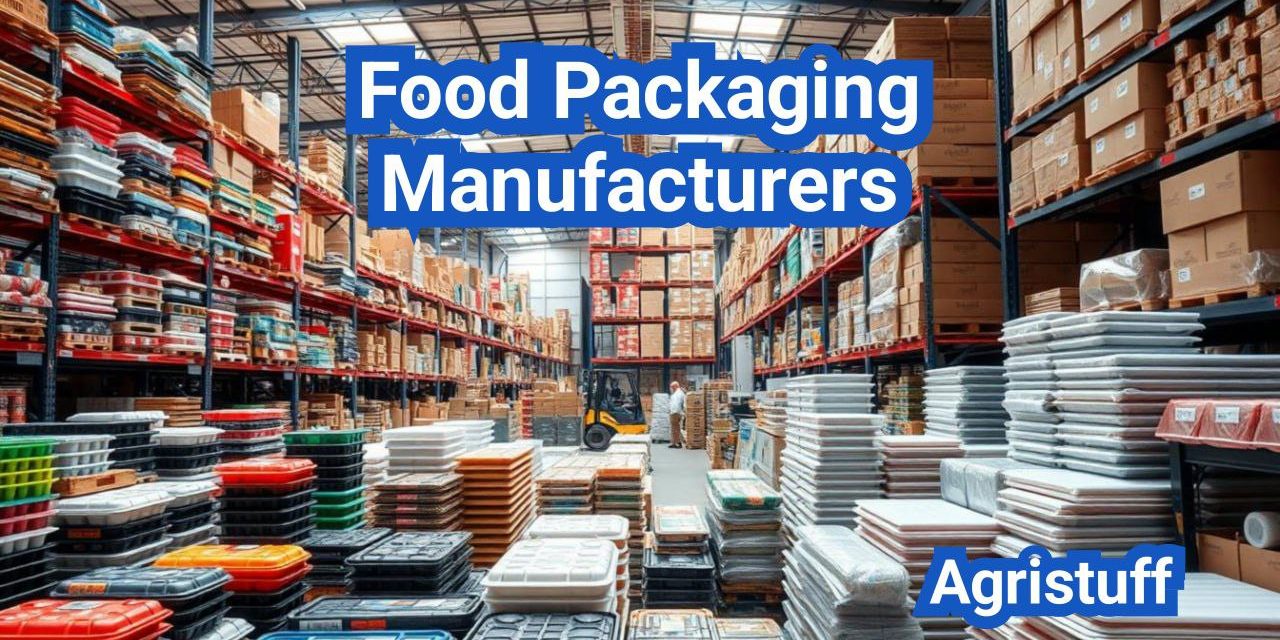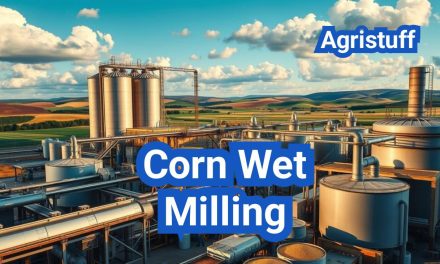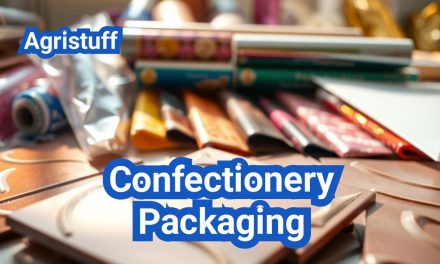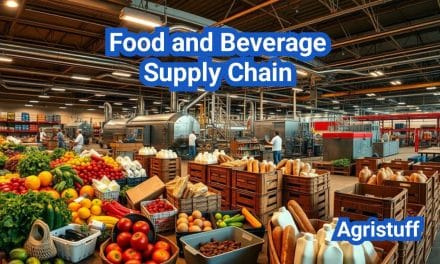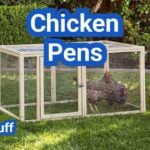The U.S. market for food packaging solutions is vast and diverse, with numerous manufacturers offering a range of products. Companies like KM Packaging and Berry Global are leading suppliers of flexible packaging solutions.
Sourcing the right trays, films, and closures is crucial for businesses in the food industry. The U.S. is home to a significant number of food packaging manufacturers that cater to various needs.
Key Takeaways
- Top food packaging companies in the U.S. offer a range of products, including trays, films, and closures.
- KM Packaging and Berry Global are leading suppliers of flexible packaging solutions.
- Sourcing the right packaging materials is crucial for businesses in the food industry.
- The U.S. food packaging industry is a significant market with various manufacturers.
- Flexible food packaging films are a popular choice among food manufacturers.
The State of Food Packaging Manufacturing in the United States
The U.S. food packaging industry is undergoing significant transformations driven by consumer demand for sustainable and convenient packaging solutions. This shift is influencing the market dynamics, driving innovation, and changing the way food packaging companies operate.
Current Market Overview and Size
The food packaging market in the United States is substantial, with a diverse range of products and applications. According to recent market research, the U.S. food packaging industry was valued at over $100 billion in 2022. Key players like Tyson Foods Inc. and Anchor Packaging are at the forefront of this market, driving growth through innovative packaging solutions.
The demand for sustainable packaging is a major factor influencing the industry. Consumers are increasingly preferring packaging that is eco-friendly and minimizes environmental impact. This trend is pushing food packaging companies to adopt sustainable practices and materials.
Key Industry Trends Shaping the Market
Several key trends are shaping the food packaging industry in the U.S. These include:
- Increased focus on sustainability and eco-friendly packaging
- Advancements in packaging technology, such as modified atmosphere packaging
- Growing demand for convenient and portable packaging solutions
- Regulatory changes impacting packaging materials and safety standards
These trends are driving innovation and competition among food packaging companies, as they strive to meet consumer demands and regulatory requirements.
Major Food Packaging Companies in the U.S.
The U.S. is home to numerous leading food packaging companies. Some of the top players include:
| Company Name | Specialization | Notable Clients |
|---|---|---|
| Tyson Foods Inc. | Protein packaging solutions | Major grocery store chains |
| Anchor Packaging | Custom packaging solutions | Foodservice providers |
| Amcor | Flexible and rigid packaging | Global food brands |
These companies are known for their innovative approaches to food packaging, including the development of sustainable packaging solutions and advanced packaging technologies.
Understanding Different Types of Food Packaging Materials

Food packaging materials have evolved to cater to various needs, from plastic-based solutions to sustainable alternatives. The choice of material depends on several factors, including the type of food, shelf life, and environmental considerations.
Plastic-Based Packaging Solutions
Plastic packaging remains a dominant force in the food industry due to its versatility, cost-effectiveness, and barrier properties. Polyethylene terephthalate (PET) and polypropylene (PP) are commonly used plastics for food packaging. PET is widely used for bottled beverages, while PP is often used for yogurt containers and bottle caps.
However, plastic packaging faces criticism for its environmental impact, including pollution and waste management issues. As a result, manufacturers are exploring alternatives and innovations to reduce plastic usage.
Paperboard and Fiber-Based Alternatives
Paperboard and fiber-based packaging offer a more sustainable option for food packaging. These materials are biodegradable, compostable, and can be sourced from recycled fibers. Craft paper and molded pulp are examples of fiber-based packaging used for products like coffee cups and egg cartons.
The use of paperboard and fiber-based materials is increasing as companies seek to reduce their environmental footprint. These materials can be printed and designed to be visually appealing, making them suitable for branding purposes.
Innovative and Sustainable Materials
The demand for sustainable packaging has driven innovation in materials science. Bioplastics, made from renewable biomass sources like corn starch or sugarcane, are gaining traction as an alternative to traditional plastics. Other innovations include edible packaging and plant-based composites.
These sustainable materials not only reduce environmental impact but also offer unique marketing opportunities for brands to highlight their eco-friendly practices.
Selecting the Right Material for Your Food Product
Choosing the appropriate packaging material involves considering factors such as product protection, shelf life, and consumer preferences. Manufacturers must balance functionality with sustainability and cost.
By understanding the different types of food packaging materials available, businesses can make informed decisions that meet their product needs and brand values.
Essential Technical Specifications for Food Packaging
To maintain product freshness and safety, food packaging must adhere to specific technical requirements. These specifications are crucial in preventing spoilage and ensuring compliance with industry regulations.
Oxygen Transmission Rate (OTR) Requirements
The Oxygen Transmission Rate (OTR) is a critical measure of a packaging material’s ability to prevent oxygen from entering the package. Low OTR values are essential for packaging oxygen-sensitive products, such as snacks, coffee, and pharmaceuticals.
- OTR testing methods include coulometric or gas chromatography analysis.
- Specifications vary based on the product’s sensitivity to oxygen.
- Manufacturers must ensure that packaging materials meet the required OTR standards.
Water Vapor Transmission Rate (WVTR) Standards
The Water Vapor Transmission Rate (WVTR) measures the rate at which water vapor passes through a packaging material. High WVTR can lead to moisture accumulation, affecting product quality. WVTR standards are particularly important for products susceptible to moisture, such as dried foods or pharmaceuticals.
- WVTR is typically measured using gravimetric or infrared detection methods.
- Packaging materials with low WVTR are preferred for moisture-sensitive products.
- Manufacturers should specify WVTR requirements based on product needs.
EVOH Barrier Packaging Technology
EVOH (Ethylene-Vinyl Alcohol) barrier packaging is widely used to prevent oxygen and moisture from affecting packaged products. EVOH provides an excellent barrier against gases, making it ideal for food packaging applications.
- EVOH is often used in multilayer packaging structures.
- It is particularly effective for packaging oxygen-sensitive foods.
- Manufacturers can customize EVOH barrier packaging to meet specific product requirements.
How to Communicate Technical Requirements to Suppliers
Effective communication of technical specifications to suppliers is crucial for ensuring that packaging meets the required standards. Clear documentation and specification sheets are essential for conveying these requirements.
- Provide detailed specification sheets outlining OTR, WVTR, and other relevant technical requirements.
- Establish clear communication channels with suppliers to address any questions or concerns.
- Regularly review and update technical specifications to ensure compliance with evolving industry standards.
Regulatory Compliance for Food Packaging in the U.S.

Ensuring regulatory compliance is crucial for food packaging manufacturers operating in the U.S. market. The regulatory landscape is complex, involving various federal and state regulations that govern the safety and quality of food packaging.
FDA Food Contact Regulations Overview
The FDA regulates food contact materials to ensure they are safe for use with food products. FDA food contact regulations require that packaging materials comply with specific guidelines to prevent contamination or adulteration of food. Manufacturers must ensure their packaging materials meet these regulations to avoid legal and financial repercussions.
Compliance involves understanding the types of materials that are permissible for food contact and ensuring that these materials are used correctly in the manufacturing process. This includes compliance with regulations regarding additives, coatings, and other substances that may come into contact with food.
GFSI Packaging Certification Requirements
GFSI (Global Food Safety Initiative) packaging certification is another critical aspect of regulatory compliance for food packaging manufacturers. GFSI certification ensures that packaging suppliers adhere to rigorous food safety standards, enhancing the overall safety of the food supply chain.
GFSI certification involves a comprehensive audit of the supplier’s facilities, processes, and quality management systems. Manufacturers should look for suppliers who have achieved GFSI certification, as this demonstrates their commitment to food safety and quality.
Verifying Supplier Compliance Documentation
Verifying supplier compliance documentation is a vital step in ensuring that packaging materials meet regulatory requirements. Manufacturers should request and review documentation from their suppliers, including certificates of compliance, test reports, and audit results.
This process helps manufacturers ensure that their suppliers are adhering to regulatory compliance standards, thereby reducing the risk of non-compliance and associated penalties.
In conclusion, regulatory compliance is a multifaceted challenge for food packaging manufacturers in the U.S. By understanding and adhering to FDA food contact regulations, pursuing GFSI packaging certification, and verifying supplier compliance documentation, manufacturers can ensure they are meeting the necessary standards for safety and quality.
How to Source Thermoformed Food Trays
Thermoformed trays have become an essential component in food packaging, and sourcing them requires careful consideration. The right thermoformed food trays can enhance product presentation, improve shelf life, and meet consumer demands for convenient packaging.
Key Manufacturers of Food Trays in the U.S.
The U.S. market is home to several leading manufacturers of thermoformed food trays. Companies like Pactiv and Genpak are renowned for their high-quality products and innovative packaging solutions. These manufacturers offer a range of thermoformed trays suitable for various food products, including meat, poultry, and seafood.
| Manufacturer | Product Range | Specialization |
|---|---|---|
| Pactiv | Thermoformed trays for meat and poultry | Innovative packaging solutions |
| Genpak | Custom and standard thermoformed trays | High-quality, durable packaging |
| Other notable manufacturers | Varied product ranges including specialty foods | Customization options and sustainability |
Selection Criteria for Food Tray Suppliers
When selecting a supplier for thermoformed food trays, several factors should be considered. These include the supplier’s experience in the industry, their ability to meet specific packaging requirements, and their commitment to quality and sustainability.
- Industry experience and reputation
- Capability to produce custom or specialty trays
- Quality control measures and certifications
- Sustainability practices and eco-friendly options
Custom vs. Standard Tray Options
One of the key decisions when sourcing thermoformed food trays is whether to opt for custom or standard tray options. Custom trays offer tailored solutions that can enhance product presentation and meet specific packaging needs, while standard trays provide a cost-effective and readily available option.
“Custom thermoformed trays can be designed to perfectly fit your product, enhancing its presentation on store shelves and providing a competitive edge in the market.”
— Packaging Expert
Ultimately, the choice between custom and standard trays depends on the specific requirements of your product and your branding strategy.
Sourcing Flexible Food Packaging Films

In the competitive food industry, selecting the appropriate flexible packaging films can significantly impact product quality and brand reputation. Flexible food packaging films are used for a range of food products, including snacks, meat, and coffee, offering a versatile solution that balances protection, preservation, and presentation.
Leading Film Manufacturers in the American Market
The American market is home to several leading manufacturers of flexible food packaging films. Companies like Berry Global and General Films offer high-quality flexible packaging solutions that cater to various food industry needs. These manufacturers provide a range of films with different properties, such as barrier protection, printability, and sealability, ensuring that food products remain fresh and appealing.
When sourcing flexible packaging films, it’s essential to evaluate the performance of different films for various food types. For instance, films used for packaging meat require high oxygen barrier properties to prevent spoilage, while films for snack foods may prioritize moisture barrier properties to maintain crispness.
Evaluating Film Performance for Different Food Types
Evaluating the performance of flexible packaging films involves assessing their technical specifications, such as oxygen transmission rate (OTR) and water vapor transmission rate (WVTR). The right film for a specific food product depends on factors like the product’s sensitivity to oxygen, moisture, and light. For example, coffee packaging often requires films with high barrier properties to preserve flavor and aroma.
- OTR and WVTR testing to ensure the film meets the required barrier properties.
- Sealability and puncture resistance to prevent leakage and damage.
- Printability and clarity for attractive packaging.
Cost Considerations for Packaging Films
Cost is a critical factor in sourcing flexible food packaging films. While high-performance films may offer superior protection and preservation, they can also be more expensive. Companies must balance the need for quality packaging with cost considerations to maintain profitability. Volume-based pricing negotiations and long-term supply agreements can help manage costs.
Additionally, considering the total cost of ownership, including factors like packaging efficiency, waste reduction, and supply chain logistics, can provide a more comprehensive understanding of the true costs involved.
Finding the Right Closure and Sealing Solutions

Closure liners and induction seals are among the critical components that ensure packaged food remains fresh and secure. The importance of selecting the right closure solution cannot be overstated, as it directly impacts the integrity and safety of the packaged product.
Closure Liners and Induction Seal Technologies
Closure liners are designed to provide a secure seal between the closure and the container, preventing leakage and contamination. Induction seals, on the other hand, use electromagnetic induction to create a tamper-evident seal. Companies like Berry Global offer a range of closure solutions that incorporate these technologies.
Induction sealing is particularly effective because it provides a visible indication of tampering, enhancing consumer trust. The technology involves a liner that is placed under the cap or closure, which is then sealed to the container using induction energy.
Top Closure Manufacturers in the U.S.
The U.S. market is home to several leading closure manufacturers, including Berry Global, AptarGroup, and Closure Systems International. These companies offer a wide range of closure solutions designed for various packaging formats.
| Manufacturer | Closure Types | Notable Features |
|---|---|---|
| Berry Global | Plastic caps, lids, and dispensing closures | Innovative materials, customizable designs |
| AptarGroup | Dispensing closures, pumps, and valves | Advanced dispensing technologies, sustainability focus |
| Closure Systems International | Dispensing closures, child-resistant closures | High-performance materials, ergonomic designs |
Matching Closures to Container Types
Selecting the right closure for a container involves considering factors such as the container material, the product being packaged, and the desired user experience. For example, a closure for a glass jar may differ significantly from one for a plastic bottle.
- Consider the compatibility of the closure with the container material.
- Assess the functional needs, such as dispensing or resealing.
- Evaluate the aesthetic appeal and brand alignment.
Testing Protocols for Closure Integrity
Ensuring the integrity of closures involves rigorous testing, including leak testing, torque testing, and application testing. These tests help verify that the closure performs as expected under various conditions.
Leak testing, for instance, is critical for assessing the closure’s ability to prevent leakage under pressure or vacuum. This is particularly important for products that are sensitive to oxygen or moisture.
Food Packaging Manufacturers: Comprehensive Supplier Evaluation

To source high-quality food packaging, manufacturers must thoroughly assess their suppliers. A comprehensive supplier evaluation is crucial for ensuring the quality, reliability, and safety of food packaging materials.
Creating a Supplier Qualification Checklist
Developing a supplier qualification checklist is a fundamental step in evaluating potential packaging suppliers. This checklist should include criteria such as regulatory compliance, quality management systems, and production capabilities. By having a clear set of qualifications, manufacturers can streamline the evaluation process and ensure that all suppliers meet the necessary standards.
Requesting Samples and Prototypes
Requesting samples and prototypes from potential suppliers is essential for assessing the quality and performance of their packaging materials. This step allows manufacturers to evaluate the material’s durability, sealing properties, and overall suitability for their products. It’s also an opportunity to test the supplier’s ability to meet specific requirements and custom specifications.
Evaluating Manufacturing Capabilities and Capacity
Assessing a supplier’s manufacturing capabilities and capacity is vital to ensure they can meet the required demand. This involves evaluating their production technology, equipment maintenance, and scalability. Manufacturers should also consider the supplier’s quality control processes and their ability to handle large or complex orders.
Conducting Supplier Facility Audits
Conducting on-site audits of a supplier’s facilities is a critical step in the evaluation process. These audits allow manufacturers to assess the supplier’s operational practices, quality management systems, and compliance with regulatory requirements. By verifying these aspects firsthand, manufacturers can gain confidence in their supplier’s ability to deliver high-quality packaging materials consistently.
Food Packaging Equipment and Machinery Sourcing

Food packaging manufacturers must navigate a complex landscape when sourcing equipment and machinery. The right equipment is crucial for efficient production, product safety, and compliance with regulations.
Milk Pouch Packing and Filling Machines
Milk pouch packing and filling machines are specialized equipment designed for efficiently packaging liquid dairy products. Companies like KM Packaging and Berry Global offer a range of machines that can handle various pouch sizes and filling requirements.
- High-speed filling capabilities
- Accurate volume control
- Compatibility with different pouch materials
Equipment for Thermoforming and Sealing
Thermoforming equipment is used to create trays and containers from plastic sheets, which are then sealed with lids or films. This process requires precise temperature control and forming technology to produce consistent, high-quality packaging.
Key considerations for thermoforming and sealing equipment include:
- Material compatibility
- Forming accuracy
- Sealing integrity
Leading Equipment Manufacturers and Suppliers
Several leading manufacturers supply food packaging equipment to the industry. These include:
- Companies specializing in thermoforming and sealing technology
- Suppliers of filling and capping machines
- Manufacturers offering integrated packaging solutions
When selecting a supplier, it’s essential to evaluate their experience, product range, and after-sales support.
Leasing vs. Purchasing Equipment Considerations
Food packaging manufacturers must decide whether to lease or purchase equipment based on their production needs and financial situation. Leasing can offer flexibility and lower upfront costs, while purchasing may provide long-term savings.
“Leasing equipment can be a cost-effective way to access the latest technology without significant capital expenditure.” – Industry Expert
Factors to consider include:
| Consideration | Leasing | Purchasing |
|---|---|---|
| Initial Cost | Lower | Higher |
| Flexibility | Higher | Lower |
| Maintenance | Often included | Responsibility of the owner |
Implementing GS1 Standards for Packaging Identification

As the food packaging industry continues to evolve, the adoption of GS1 standards for packaging identification has become a necessity. GS1 standards, including Global Trade Item Numbers (GTIN) and Universal Product Codes (UPC), are crucial for product identification, inventory management, and supply chain efficiency.
Understanding GTIN and UPC Requirements
GTIN and UPC are essential components of GS1 standards used for identifying products. GTIN is a unique identifier for trade items, while UPC is a specific type of barcode used for product labeling. To comply with GS1 standards, businesses must understand the requirements for GTIN and UPC implementation.
The process involves assigning a unique GTIN to each product variant and ensuring that the corresponding UPC barcode is correctly printed on the packaging. This requires coordination with suppliers and packaging manufacturers to guarantee compliance.
Working with Suppliers on Barcode Implementation
Effective implementation of GS1 standards requires close collaboration with suppliers. Companies must communicate their GTIN and UPC requirements clearly to their suppliers to ensure that packaging materials are produced with the correct barcodes.
To facilitate this process, businesses can take the following steps:
- Provide clear specifications for GTIN and UPC implementation to suppliers.
- Verify that suppliers have the necessary capabilities to produce compliant packaging materials.
- Conduct regular audits to ensure ongoing compliance with GS1 standards.
By working closely with suppliers and adhering to GS1 standards, companies can improve their supply chain efficiency and reduce the risk of non-compliance.
| GS1 Standard | Description | Benefits |
|---|---|---|
| GTIN | Unique identifier for trade items | Improved product identification, inventory management |
| UPC | Barcode used for product labeling | Enhanced supply chain efficiency, reduced errors |
| GS1 Compliance | Adherence to GS1 standards for packaging identification | Better supply chain visibility, reduced costs |
Sustainable Packaging Solutions and Manufacturers

Sustainable packaging is no longer a trend but a necessity for food manufacturers looking to reduce their environmental footprint.
As consumers become more environmentally conscious, the demand for eco-friendly packaging solutions has surged. This shift is driving innovation in the packaging industry, with manufacturers exploring various sustainable materials and technologies.
Biodegradable and Compostable Options
Biodegradable and compostable packaging materials are gaining popularity as alternatives to traditional plastics. These materials, often derived from plant-based sources such as cornstarch or sugarcane, offer a reduced carbon footprint and can significantly decrease the amount of waste sent to landfills.
Companies like BioBag and Compostable Packaging Products are leading the way in providing biodegradable packaging solutions. Their products range from compostable bags to biodegradable food containers, catering to various packaging needs in the food industry.
Recycled Content Packaging Suppliers
Another approach to sustainable packaging involves the use of recycled content. By incorporating recycled materials into packaging products, manufacturers can reduce the demand for virgin materials and lower their environmental impact.
Suppliers such as Sonoco and Amcor offer a range of packaging solutions with recycled content. These products not only contribute to a more circular economy but also appeal to consumers who prioritize environmental sustainability.
Cost Premium Considerations for Eco-Friendly Packaging
While sustainable packaging offers numerous benefits, it often comes with a higher upfront cost compared to traditional packaging materials. The cost premium associated with eco-friendly packaging can be a barrier for some businesses.
However, it’s essential to consider the long-term advantages, including enhanced brand reputation and compliance with increasingly stringent environmental regulations. Companies can also explore cost-saving strategies such as optimizing packaging design and reducing material usage.
| Packaging Material | Cost Premium | Environmental Benefit |
|---|---|---|
| Biodegradable Plastics | 15-20% higher | Reduced landfill waste |
| Recycled Content Packaging | 5-15% higher | Lower carbon footprint |
Marketing Benefits of Sustainable Packaging
Adopting sustainable packaging can have significant marketing benefits. It can enhance a brand’s image, foster customer loyalty, and provide a competitive edge in the market.
By clearly communicating their commitment to sustainability through packaging, companies can resonate with environmentally conscious consumers and differentiate themselves from competitors.
In conclusion, sustainable packaging is a vital strategy for food manufacturers aiming to reduce their environmental impact while meeting consumer demands for eco-friendly products. By exploring biodegradable, compostable, and recycled content packaging solutions, businesses can achieve both sustainability and market success.
Cost Optimization Strategies for Packaging Procurement

In the realm of food packaging, cost optimization is not just about reducing expenses, but also about maximizing value. Companies can achieve significant savings and operational efficiencies by implementing effective cost optimization strategies in their packaging procurement processes.
Volume-Based Pricing Negotiations
One of the most effective ways to optimize packaging procurement costs is through volume-based pricing negotiations. By committing to larger order volumes, businesses can often secure better pricing from suppliers. This strategy requires careful planning and forecasting to ensure that the increased inventory does not lead to waste or unnecessary storage costs.
To successfully negotiate volume-based pricing, companies should:
- Analyze historical purchasing data to identify trends and opportunities for consolidation.
- Develop a robust forecasting model to predict future packaging needs.
- Engage in discussions with suppliers to understand their volume discount structures.
Managing Freight and Logistics Costs
Another critical aspect of cost optimization in packaging procurement is managing freight and logistics costs. The transportation of packaging materials from suppliers to manufacturing facilities can significantly impact overall expenses. Companies can reduce these costs by:
- Optimizing shipping routes and consolidating shipments.
- Negotiating with carriers for better rates.
- Considering alternative transportation modes, such as rail or sea freight, for non-time-sensitive shipments.
Total Cost of Ownership Considerations
When evaluating packaging procurement options, businesses must consider the total cost of ownership (TCO). TCO encompasses not just the initial purchase price of packaging materials, but also costs associated with storage, handling, and disposal. By analyzing TCO, companies can make more informed decisions that may lead to long-term savings.
Key factors to include in TCO calculations are:
- Initial packaging material costs.
- Shipping and handling expenses.
- Storage and inventory management costs.
- Waste disposal and recycling fees.
Building Long-Term Supplier Relationships
Developing long-term relationships with reliable suppliers is a crucial strategy for optimizing packaging procurement costs. Strong supplier partnerships can lead to better pricing, improved service levels, and collaborative innovation. To foster these relationships, companies should:
- Communicate clearly and transparently with suppliers.
- Engage in joint planning and forecasting activities.
- Recognize and reward supplier performance and innovation.
By implementing these cost optimization strategies, businesses can achieve significant savings in their packaging procurement processes while maintaining or even improving the quality of their packaging solutions.
Building Successful Packaging Supply Chains
Building successful packaging supply chains requires careful planning, thorough supplier evaluation, and a focus on sustainability. By understanding the complexities of food packaging manufacturing, businesses can make informed decisions when sourcing trays, films, and closures.
Effective supply chain management is crucial in ensuring that packaging materials meet regulatory requirements, are cost-effective, and align with brand values. Companies like Amcor and Sealed Air have demonstrated the importance of integrating sustainability into their packaging solutions.
To achieve successful packaging supply chains, businesses must prioritize supplier qualification, invest in sustainable materials, and optimize cost strategies. By doing so, they can enhance their brand reputation, reduce environmental impact, and improve their bottom line.
Ultimately, a well-managed packaging supply chain is key to delivering high-quality products to consumers while maintaining a competitive edge in the market.
FAQ
What are the key factors to consider when sourcing food packaging materials?
When sourcing food packaging materials, consider factors such as material type, durability, barrier properties, regulatory compliance, and sustainability. The choice of material will depend on the specific food product, its shelf life, and storage conditions.
What is the difference between OTR and WVTR in food packaging?
OTR (Oxygen Transmission Rate) measures the rate at which oxygen passes through a packaging material, while WVTR (Water Vapor Transmission Rate) measures the rate at which water vapor passes through. Both are critical in maintaining the quality and shelf life of food products.
How do I ensure that my food packaging supplier is compliant with FDA regulations?
To ensure FDA compliance, verify that your supplier adheres to FDA food contact regulations, has necessary certifications such as GFSI, and provides documentation to support compliance. Regular audits and inspections can also help ensure ongoing compliance.
What are the benefits of using thermoformed food trays?
Thermoformed food trays offer benefits such as customized shapes and sizes, improved product visibility, and enhanced protection during transportation. They can be made from various materials, including plastic and bioplastics, and can be designed for specific food products.
How do I evaluate the performance of flexible food packaging films?
To evaluate the performance of flexible food packaging films, consider factors such as barrier properties, puncture resistance, and seal strength. Testing protocols such as ASTM or ISTA can help assess the film’s performance under various conditions.
What are the different types of closure and sealing solutions available for food packaging?
Closure and sealing solutions include closure liners, induction seals, and various types of lids and caps. The choice of closure will depend on the container type, product requirements, and desired level of tamper-evidence.
How do I implement GS1 standards for packaging identification?
To implement GS1 standards, understand GTIN and UPC requirements, and work with your supplier to ensure compliance. GS1 standards help ensure accurate and efficient tracking and identification of products throughout the supply chain.
What are the benefits of using sustainable packaging solutions?
Sustainable packaging solutions, such as biodegradable and compostable options, offer benefits such as reduced environmental impact, enhanced brand reputation, and potential cost savings. They can also help meet consumer demand for eco-friendly packaging.
How can I optimize costs for packaging procurement?
To optimize costs, consider strategies such as volume-based pricing negotiations, managing freight and logistics costs, and evaluating the total cost of ownership. Building long-term supplier relationships can also help drive cost savings.
What are the key considerations when sourcing food packaging equipment and machinery?
When sourcing food packaging equipment and machinery, consider factors such as equipment type, production capacity, and maintenance requirements. Leasing vs. purchasing equipment can also impact costs and flexibility.
Conclusion of: Food Packaging Manufacturers In USA
Why this guide matters for sourcing from food packaging manufacturers
Choosing the right food packaging manufacturers can determine shelf life, compliance, and unit economics for your brand. The U.S. market has specific rules for food-contact materials, and your purchasing decisions need to align with those rules while hitting performance and sustainability targets. This practical guide explains how to source trays, films, and closures from U.S. food packaging manufacturers, what to ask for in specs, and how to qualify vendors without slowing down launches. FDA: Determining Regulatory Status
Regulatory basics every buyer should know before contacting food packaging manufacturers
In the U.S., food packaging manufacturers must meet FDA regulations for indirect food additives—materials that contact food but aren’t ingredients. These rules live in 21 CFR Parts 174–178 and require “suitable purity,” migration within limits, and good manufacturing practice. When you build supplier checklists for food packaging manufacturers, align your specs with these parts and ask vendors how each layer of a package is cleared for your intended use. 21 CFR 174.5: General Provisions
Confirm the regulatory path when evaluating food packaging manufacturers
Ask food packaging manufacturers to state the exact regulatory path for each component: FDA regulation (e.g., 21 CFR 175/176/177/178), a Food Contact Notification (FCN), prior sanction, or GRAS for packaging. Require a bill of materials identifying each resin, additive, coating, adhesive, and closure liner—and the associated clearance—so you can file it in your technical dossier when choosing food packaging manufacturers. FDA: Regulatory Status for Food-Contact Components
Trays: material choices to request from food packaging manufacturers
Thermoformed trays from U.S. food packaging manufacturers are typically APET/CPET or PP for ovenable and high-heat use; PS and paper-based options appear in low-heat or dry applications. When you spec trays from food packaging manufacturers, link the tray resin to the correct polymer regulation (e.g., PET under 21 CFR 177.1630 or olefin polymers like PP under 21 CFR 177.1520) and define use temperature, contact time, and food type (aqueous, acidic, alcoholic, fatty). 21 CFR 177.1630 (PET)
Films 101: barrier fundamentals when vetting food packaging manufacturers
For flexible packaging from food packaging manufacturers, you’ll balance cost, machinability, and barrier. Specify oxygen transmission rate (OTR) and water vapor transmission rate (WVTR) at the test conditions that reflect your product and route-to-market. Require certified test reports from food packaging manufacturers that cite the appropriate ASTM methods. ASTM F1249 (WVTR)
EVOH and high barrier films from food packaging manufacturers
Many food packaging manufacturers deliver multilayer films with EVOH to control oxygen ingress and preserve flavor and color in products like sauces, dairy, and snacks. EVOH barrier depends on grade and humidity, so ask food packaging manufacturers for OTR curves at multiple RH levels and confirm layer placement and tie resins in coex structures. EVOH Oxygen-Barrier Basics
Seal layers and sealing windows from food packaging manufacturers
Reliable seals prevent leakers and spoilage, so require seal-initiation temperature, hot-tack strength, and contamination-through-seal performance from food packaging manufacturers. Sealants may be LLDPE, metallocene PE, or ionomers used in demanding applications; discuss line speeds and jaw dwell times with food packaging manufacturers before locking specs. Ionomer Seal Layer Overview
Closures and liners: what to ask food packaging manufacturers to document
When buying caps, fitments, and liners from food packaging manufacturers, reference the closure/liner regulation and liner type (e.g., induction seal, pulp/foil) and specify torque, thread finish, and liner compatibility with your product and fill temperatures. Confirm that liner compositions meet the FDA closure gasket regulation and that your food packaging manufacturers provide consistent peel strength. 21 CFR 177.1210 (Closures with Sealing Gaskets)
Adhesives and coatings: verify layers with food packaging manufacturers
Laminations and coated papers require the right adhesive and coating clearances. Ask food packaging manufacturers to disclose adhesive chemistry and coating components, then confirm they’re cleared for your use (e.g., 21 CFR 175.105 and 175.300). Verify residual monomers/solvents to ensure sensory neutrality—critical when comparing food packaging manufacturers. 21 CFR 175.105 (Adhesives)
Good manufacturing practice (GMP) expectations for food packaging manufacturers
FDA requires suitable purity and GMP for food-contact materials, so ensure food packaging manufacturers can demonstrate contamination controls, traceability, and lot-level documentation. Your quality agreement should reference purity and GMP obligations and define how food packaging manufacturers handle deviations and corrective actions. 21 CFR 174.5 (GMP for Food-Contact)
When recycled content is in scope, ask food packaging manufacturers for FDA positions
If you require PCR content, ask food packaging manufacturers for the reclaim source, decontamination method, and whether FDA has issued a “no objection letter” (LNO) for that process and feedstock. Formal FDA guidance explains chemistry considerations; use it to standardize your RFP across food packaging manufacturers. FDA: Recycled Plastics in Food Packaging
Supplier certification signals to prioritize with food packaging manufacturers
Third-party certification under GFSI-recognized programs (e.g., BRCGS Packaging Materials, FSSC 22000, SQF) is a strong indicator of mature systems. Require copies of current certificates and scope statements from food packaging manufacturers and note surveillance schedules and nonconformities. GFSI-Recognised Certification Program Owners
FSMA and plant integration: align food packaging manufacturers with your food safety plan
While packaging plants aren’t under your Part 117 hazard plan, your facility must control hazards from materials and suppliers. Ensure food packaging manufacturers support your preventive controls with COAs, change notifications, and migration data needed for verification—especially when you change products or run seasonal lines. FDA: CGMP & Preventive Controls (Part 117)
Performance testing you should require from food packaging manufacturers
Specify barrier (OTR/WVTR) and cite methods in your RFQ so food packaging manufacturers return comparable data. For oxygen, reference ASTM D3985; for moisture, reference ASTM F1249. For trays and lidded packs, request seal strength curves at multiple temperatures/humidity and through-contamination to compare food packaging manufacturers fairly. ASTM D3985 (OTR)
Traceability & barcodes: what to align with food packaging manufacturers
Retail and eCom buyers expect GS1 identifiers. Ask food packaging manufacturers to prepress UPC/GTIN correctly on retail packs and cases and to encode lot codes that support recalls. Provide your GTIN assignments and artwork rules so food packaging manufacturers print the right symbology and quiet zones. GS1 US: What is a GTIN?
Labeling claims & recyclability: what to watch with food packaging manufacturers
Be careful with recyclability marks and resin codes. California SB 343 restricts “recyclable” claims and use of chasing arrows unless criteria are met, so ensure food packaging manufacturers follow your legal guidance and state-specific requirements when printing packaging. CalRecycle: Accurate Recycling Labels (SB 343)
Where to find U.S. food packaging manufacturers for trays
Industry directories can speed up shortlisting. Use vetted directories to discover domestic thermoformers, then down-select by material, forming method, and certification scope. When contacting food packaging manufacturers, attach a one-page spec and target volumes to accelerate quoting. Thomasnet: Food Trays Manufacturers
Where to find flexible film food packaging manufacturers
To source converters for pouches, lidding, or bag stock, use national directories and filter for flexible packaging capability and food-contact expertise. Ask food packaging manufacturers for film stack diagrams and run samples on your packaging lines before committing. Thomasnet: Packaging Suppliers
Finding co-packers that work with your chosen food packaging manufacturers
If you need pilots or speed to shelf, co-packers can bridge the gap while your team qualifies food packaging manufacturers. Look for plants with your process capability and regional distribution fit, then coordinate specs so the co-packer and food packaging manufacturers agree on tolerances and QA checks. Thomasnet: Co-Packing Companies
Documentation pack to request from short-listed food packaging manufacturers
Before first article approval, require a documentation bundle: regulatory clearances for each layer, migration/NIAS rationale, test reports (ASTM methods), GFSI-recognized certificate, change-control policy, and lot traceability. This lets food packaging manufacturers show readiness and reduces surprises during audits. FDA: Food-Contact Documentation
Independent testing partners to backstop food packaging manufacturers
Use third-party labs for method validation, migration modeling, or comparative barrier testing across food packaging manufacturers. Independent data helps resolve disputes and supports retailer technical reviews. Build this into timelines so lab lead-times don’t delay launches with your chosen food packaging manufacturers. UL Solutions: Food-Contact Testing
Quality agreements and change control with food packaging manufacturers
Quality agreements should define notification thresholds (e.g., resin supplier change, additive package alteration, tooling changes) and re-qualification triggers. Require food packaging manufacturers to provide advance notice and samples for line trials whenever a significant change is planned, protecting your brand’s consistency. Plastics Industry: GMP Guideline
Specifying barrier targets in RFQs to compare food packaging manufacturers fairly
Write barrier targets with the test method and conditions so bids are apples-to-apples across food packaging manufacturers. For oxygen, cite ASTM D3985 and your storage RH; for water vapor, cite ASTM F1249 and relevant temperature. This helps food packaging manufacturers propose the right structures without over-engineering. ASTM F1249 (Specify WVTR)
Closing the loop on traceability with food packaging manufacturers
Provide your GS1 Company Prefix/GTINs and require case labels that match your WMS and retailer portals. Confirm barcode grade requirements and have food packaging manufacturers provide press proofs and verification reports so your first runs scan cleanly at DCs and stores. GS1 US: How to Get a UPC
Final thought
The best food packaging manufacturers combine regulatory fluency, consistent quality, and the right material science for your product’s route-to-market. Treat your RFQ as a technical dossier, insist on verifiable data (regulatory, barrier, and sealing), and align on change control up front. If you do, you’ll select food packaging manufacturers that protect shelf life, simplify audits, and future-proof your portfolio as sustainability and labeling rules evolve. GFSI: Certification Overview
Sources & References
FDA – Determining Regulatory Status of Food-Contact Components
21 CFR 174.5 – General Provisions (GMP)
21 CFR 177.1630 – PET Polymers
21 CFR 177.1210 – Closures with Sealing Gaskets
ASTM D3985 – Oxygen Transmission Rate
ASTM F1249 – Water Vapor Transmission Rate
Dow – Surlyn Ionomers (Seal Layers)
GFSI – Recognised Certification Programme Owners

